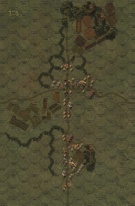The Wattrelos Counter Attack
Road to Dunkirk #9
|
|
(Defender)
Germany
|
vs |
Britain
(Attacker)
|
|
|
|
Total |
| Side 1 |
0 |
| Draw |
2 |
| Side 2 |
0 |
|
Total |
| Side 1 |
0 |
| Draw |
2 |
| Side 2 |
0 |
|
Total |
| Side 1 |
0 |
| Draw |
0 |
| Side 2 |
0 |
|
| Overall Rating, 2 votes |
|---|
|
|
|
Scenario Rank:
--- of 964 |
| Parent Game |
Road to Dunkirk |
| Historicity |
Historical |
| Date |
1940-05-24 |
| Start Time |
19:00 |
| Turn Count |
12 |
| Visibility |
Day & Night |
| Counters |
55 |
| Net Morale |
0 |
| Net Initiative |
2 |
| Maps |
2: 125, 126 |
| Layout Dimensions |
56 x 43 cm
22 x 17 in |
| Play Bounty |
148 |
| AAR Bounty |
223 |
| Total Plays |
2 |
| Total AARs |
0 |
|
Introduction
|
|
On 22 May, Montgomery’s 3rd Division was back where it had started before the German advance, occupying the prepared defenses of the Gort Line near Roubaix. Since German activity was quite limited, Brigadier Frank Witts of 8th Infantry Brigade ordered a counterattack to reach a railway line about 1,000 yards in front of the forward position. With no supporting artillery, the operation had the sole aim of raising morale. Each of the brigade’s three battalions provided two companies with two machine guns platoons of the 2nd Middlesex as flank protection.
|
|
Conclusion
|
|
The right battalion found the enemy established in some strength and could make no progress, suffering considerable casualties; the center battalion got further and suffered less; the left battalion reached their objective with little opposition. Battalions were ordered to lead with their carriers, as if they were tanks. In spite of the carrier platoons’ losses, the companies fought their way forward, took prisoners and returned. However they suffered very severe casualties. Witts, an aide to King George VI just before the war, could not be disciplined but was never trusted with a combat command again.
|
Display Relevant AFV Rules
| AFV Rules Pertaining to this Scenario's Order of Battle |
- Vulnerable to results on the Assault Combat Chart (7.25, 7.63, ACC), and may be attacked by Anti-Tank fire (11.2, DFT). Anti-Tank fire only affects the individual unit fired upon (7.62, 11.0).
- AFV's are activated by tank leaders (3.2, 3.3, 5.42, 6.8).
They may also be activated as part of an initial activating stack, but if activated in this way would need a tank
leader in order to carry out combat movement.
- AFV's do not block Direct Fire (10.1).
- Full-strength AFV's with "armor efficiency" may make two anti-tank (AT) fire attacks per turn
(either in their action segment or during opportunity fire) if they have AT fire values of 0 or more
(11.2).
- Each unit with an AT fire value of 2 or more may fire at targets at a distance of between 100% and 150% of its
printed AT range. It does so at half its AT fire value. (11.3)
- Efficient and non-efficient AFV's may conduct two opportunity fires per turn if using direct fire
(7.44, 7.64).
Units with both Direct and AT Fire values may use either type of fire in the same turn as their opportunity fire,
but not both (7.22, 13.0).
Units which can take opportunity fire twice per turn do not have to target the same unit both times (13.0).
- Demoralized AFV's are not required to flee from units that do not have AT fire values (14.3).
- Place a Wreck marker when an AFV is eliminated in a bridge or town hex (16.3).
- AFV's do not benefit from Entrenchments (16.42).
- AFV's may Dig In (16.2).
- Open-top AFV's: Immune to M, M1 and M2 results on Direct and Bombardment Fire Tables, but DO take step losses from X and #X results (7.25, 7.41, 7.61, BT, DFT). If a "2X" or "3X" result is rolled, at least one of the step losses must be taken by an open-top AFV if present.
- APC – Armored Personnel Carrier: These are Combat Units, but stack like Transports. They can transport personnel units or towed units. They are not counted as combat units for the +1 stacking modifier on the Direct Fire and Bombardment Tables (4.4). They may be activated by regular leaders and tank leaders (1.2, 3.34, 4.3, 5.43). They do not provide the +1 Assault bonus (ACC).
|
| 3 Errata Items |

|
All Bren carriers should have a movement value of 7.
|

|
Two British infantry have their full strengths printed on the back. They should both be "2-3" when reduced.
|

|
The reduced direct fire value of the Heer HMG became 5-5 starting with Fall of France.
|





 RtDk008
RtDk008 















